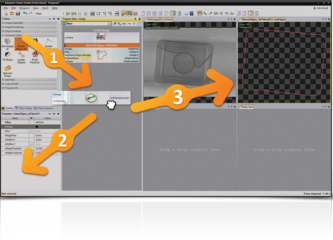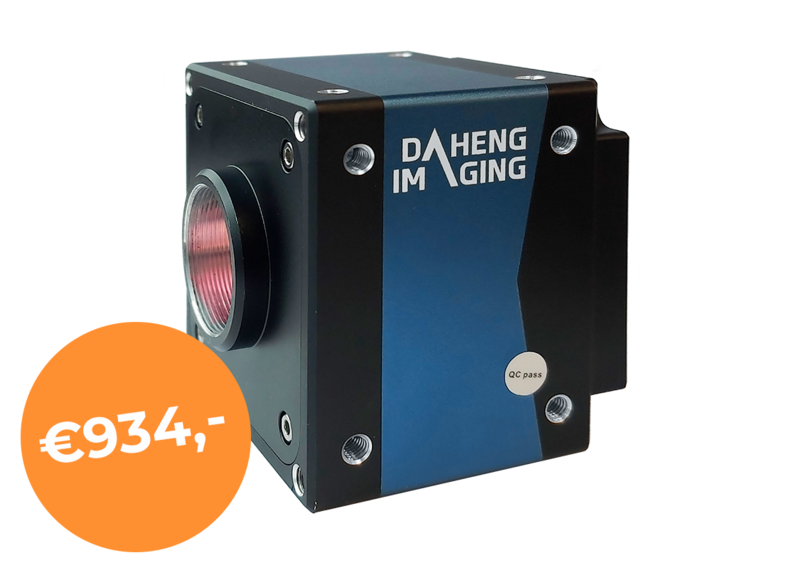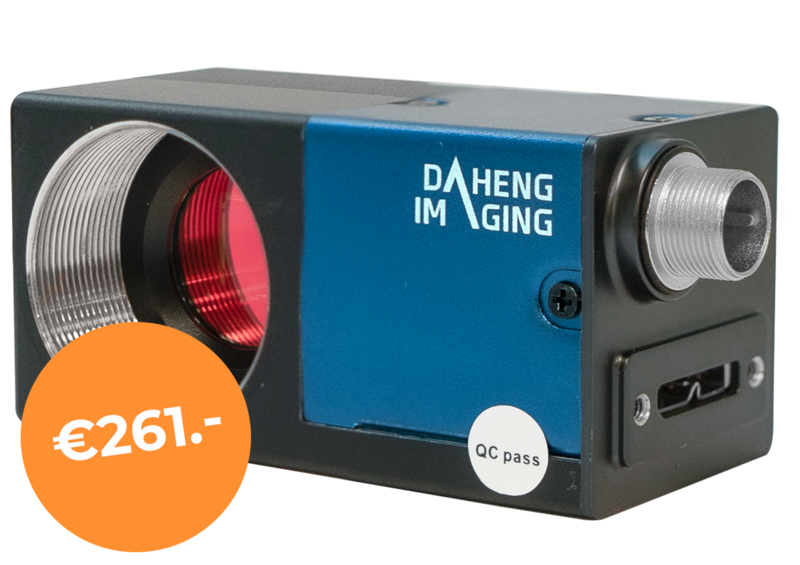AGE 145 - g 145

TOP 5 Machine Vision Kameras Schnittstellen Es gibt viele Schnittstellen für Machine Vision Kameras, auch bekannt als industrielle Bildverarbeitungskameras. Die folgende Tabelle zeigt eine Zusammenfassung aller Schnittstellen und wir werden die 7 industriellen Bildverarbeitungs-Kamera-Schnittstellen, die wir anbieten, weiter diskutieren. USB2 USB3 FireWire GigE CameraLink Coaxpress 5GigE 10GigE Supported by GeT Cameras Yes Yes No Yes No No Yes Yes Bandwidth (Megabyte/s) 40 400 80 100 Base = 250 Medium = 500 Full = 750 1 lane = 750 2 lanes = 1500 3 lanes = 2250 4 lanes = 3000 500 1000 Cable length (maximum) 5m 4.6m 10m 100m 7m 100m 100m 100m Power + data on one cable Yes Yes Yes Only if PoE PoCL Yes Only if PoE Only if PoE Frame-grabber mandatory No No Yes No Yes Yes Yes Yes Cable costs Low Low Medium Low High Low Low Low Camera costs Very low Low Low Low High High Medium High CPU usage Medium Low Low Medium Low Low Medium Medium Customer acceptance Fair Good Fair Good Declining Growing Growing Growing Multiple cameras Fair Excellent Excellent Good Fair Excellent Excellent Excellent Eine USB3 Industriekamera bei GeT Cameras kaufen Verschiedene Schnittstellen kommen bei Kameraangeboten für die Industrie zum Einsatz. Die bekanntesten sind USB2, USB3, FireWire, GigE, CameraLink, Coaxpress, 5GigE und 10GigE. Die USB2.0 Industriekamera Schnittstelle ist die preisgünstigste und sehr einfach über bestehende Anschlüsse zu integrieren. Eine USB2.0 Industriekamera eignet sich ideal für Anwendungen, die maximal 1,3 MP bei 30 fps oder 5MP bei 7 fps bei einer Kabellänge von bis zu 5 Metern erfordern. Die USB3.0 Vision Schnittstelle für industrielle Bildverarbeitungskameras ist eine der schnellsten Schnittstellen mit der größten Bandbreite. Sie erfordert am wenigsten Prozessorleistung am Computer. Deshalb ist sie ideal für hochauflösende und schnelle Kamerasensoren. Die Kabellänge ist hingegen auf 4,6 Meter begrenzt. GeT Cameras verfügt über ein starkes Portfolio an Machine Vision USB3.0 Industriekameras. Durchstöbern Sie unser Angebot oder lassen Sie sich persönlich beraten. Ein breites Angebot an GigE Industriekameras von Daheng Imaging Die Standard-GigE Vision Industriekamera Schnittstelle wird häufig in Bildverarbeitungsanwendungen verwendet, die längere Kabellängen erfordern. Als neuere Version ist auch die 5GigE Vision Schnittstelle verfügbar. Diese komprimiert die Bilder ohne Verlust an Bildqualität. Der PC dekomprimiert sie dann im Treiber, wodurch die Bandbreite erhöht wird. Diese Schnittstelle ist sehr interessant für industrielle Kameraanwendungen mit langen Kabellängen und hohen Auflösungen. Eine weitere Version ist die 10GigE Vision Industriekamera. Sie benötigt eine 10GigE-Infrastruktur, bzw. einen PC mit einem 10GigE-Anschluss. Diese Schnittstelle hat die höchste Bandbreite. GigE, 5GigE und USB3 bieten ausreichend Bandbreite für die meisten industriellen Kameraanwendungen. Das 10GigE Vision Industriekamera interface wurde daher für High-End-Anwendungen entwickelt. Unterschiede zwischen industriellen Bildverarbeitungskameras und Machine Vision Kameras Industrielle Bildverarbeitungskameras und Machine Vision Kameras sind Begriffe, die beide für industrielle Kameras verwendet werden. Beide Arten von Kameras werden in der Industrie für verschiedene Anwendungen eingesetzt. Während sich industrielle Bildverarbeitungskameras meist auf eine breite Kategorie von Kameras für industrielle Anwendungen beziehen, werden Machine-Vision-Kameras meist als Kameras bezeichnet, die für Machine-Vision-Anwendungen entwickelt wurden. Der Begriff "industrielle Bildverarbeitungskameras" kann auch andere Kameratypen wie Infrarot- oder Hochgeschwindigkeitskameras umfassen. Beide Kameratypen sind auch in unserem Portfolio von Bildverarbeitungskameras erhältlich. Besuchen Sie unsere SWIR-Kameraseite für Kurzwellen-Infrarotkameras oder unsere USB3-Kameraseite für Hochgeschwindigkeitskameras. Zusammenfassend kann man sagen, dass sowohl die Begriffe Bildverarbeitungskameras als auch industrielle Bildverarbeitungskameras verwendet werden können, wenn man nach einer Kamera für Anwendungen wie Automatisierung, Qualitätskontrolle, Inspektion und Messung sucht. Die Einsatzgebiete der industriellen Kameratechnik Eine industrielle Bildverarbeitungskamera kann in unterschiedlichen Branchen eingesetzt werden. Zum Beispiel in der pharmazeutischen Industrie für die Inspektion von Produkten wie Kapseln, Injektionsspritzen, Verschlüssen, Verpackungsetiketten usw. Im Verkehr und Transport kommen Machine Vision Kameras für Schieneninspektionen, automatische Kennzeichenerkennung (ANPR), Geschwindigkeitskontrollen, Straßeninspektionen oder 360-Grad-Bildgebungen zum Einsatz. Auch 3D-Scanner enthalten Industriekameratechniken und erzeugen so eine 3D-Punktwolke. Diese werden verwendet, um die Höhe eines Produkts, den Abstand eines Objekts oder die Überprüfung auf Fehler an einem Produkt auszuführen. In der Logistik erfolgt die Barcodelesung, DMC-Lesung oder Lesung der Verpackungsprüfmaße mit der Industriekamera. Dieselbe Technik wird auch bei Automatisierungen wie Robotern, optischen Leitsystemen oder Qualitätsprüfungen eingesetzt. Lassen Sie sich von Get Cameras beraten Industrielle Kameratechnik ist selbstverständlich nicht nur der Industrie vorbehalten. Auch in der Medizin und im Sport wird sie verwendet. In der Medizin finden sich immer mehr Geräte mit Industriekameratechnik wie Endoskope, Hornhautanalysator, Übersichtskamera im MRT, Roboterchirurgie, Digitalmikroskope. Die Kameraangebote von Daheng Imaging sind auch für solche Anwendungen geeignet. Gerne beraten wir Sie rund um das Thema Industriekamera. Im Sport kann die Industriekamera die Bewegungen von Athleten und Objekten verfolgen. In welchem Gebiet Sie auch immer Kameraanwendungen einsetzen möchten, wir von GeT Cameras bieten Ihnen exklusiv die besten Lösungen von Daheng Imaging. Bei Fragen zur industriellen Kameratechnik, zu den angebotenen Modellen und Schnittstellen stehen wir von GeT Cameras als europäische Vertriebspartner von Daheng Imaging gerne zur Verfügung.
Industrial Camera price
Sample Size and Depth of Field: Compound microscopes are designed to observe thin, transparent specimens placed on glass slides. They offer a narrow depth of field, allowing clear focus on one plane at a time. Other microscopes, like stereo or electron microscopes, can accommodate larger specimens or samples with more depth, providing a wider depth of field.
Condenser Lens: The purpose of the condenser lens is to focus the light onto the specimen. Condenser lenses are most useful at the highest powers (400x and above). Microscopes with in-stage condenser lenses render a sharper image than those with no lens (at 400x). If your microscope has a maximum power of 400x, you will get the maximum benefit by using a condenser lenses rated at 0.65 NA or greater. 0.65 NA condenser lenses may be mounted in the stage and work quite well. A big advantage to a stage mounted lens is that there is one less focusing item to deal with. If you go to 1000x then you should have a condenser lens with an N.A. of 1.25 or greater. All of our 1000x microscopes use 1.25 Abbe condenser lens systems. The Abbe condenser lens can be moved up and down. It is set very close to the slide at 1000x and moved further away at the lower powers.
How to Focus Your Microscope: The proper way to focus a microscope is to start with the lowest power objective lens first and while looking from the side, crank the lens down as close to the specimen as possible without touching it. Now, look through the eyepiece lens and focus upward only until the image is sharp. If you can't get it in focus, repeat the process again. Once the image is sharp with the low power lens, you should be able to simply click in the next power lens and do minor adjustments with the focus knob. If your microscope has a fine focus adjustment, turning it a bit should be all that's necessary. Continue with subsequent objective lenses and fine focus each time.
We offer dielectric laser mirrors for laser lines, for narrowband or broadband wavelength ranges covering spectrum from UV to IR. Wide selection of round, ...
Industrial cameras for image processing
Rack Stop: This is an adjustment that determines how close the objective lens can get to the slide. It is set at the factory and keeps students from cranking the high power objective lens down into the slide and breaking things. You would only need to adjust this if you were using very thin slides and you weren't able to focus on the specimen at high power. (Tip: If you are using thin slides and can't focus, rather than adjust the rack stop, place a clear glass slide under the original slide to raise it a bit higher).
Lens Adapters. Lens mount adapters are designed to attach a lens to a camera body with non-matching mounts. Generally, a lens can be easily adapted to a ...
1. Ocular eyepiece lens to look through. 2. Objective lens, closest to the object. Before purchasing or using a compound microscope, it is important to know the functions of each part. This information is presented below. Links will take you to additional information and images.
Baumer camera price
Nov 27, 2006 — If you want to place a pinhole at a focal length of 30mm, then the .2mm will give you an aperture of 30mm/150, or the .3mm will give you an ...
Dec 21, 2009 — Put a scale on your pictures, count the pixels needed for a length of 1mm, then multiply your number of pixels with (1/pixels per mm)^2. As easy ...
Objective Lenses: Compound microscopes have multiple objective lenses mounted on a rotating nosepiece, typically with magnifications ranging from 4x to 100x or higher. Other microscopes, such as dissecting or stereo microscopes, usually have fixed magnification lenses.
Industrial cameras
It's important to note that the term "other microscope parts" is quite broad and can include various microscope types with different designs and features. The above differences are generalized and may not apply to every microscope outside the category of compound microscopes.
Dec 17, 2023 — Objective lenses are the primary lenses closest to the object being looked at in a microscope. They are like the eyes of the microscope.
Illuminator: A steady light source (110 volts) used in place of a mirror. If your microscope has a mirror, it is used to reflect light from an external light source up through the bottom of the stage.

Diaphragm or Iris: Many microscopes have a rotating disk under the stage. This diaphragm has different sized holes and is used to vary the intensity and size of the cone of light that is projected upward into the slide. There is no set rule regarding which setting to use for a particular power. Rather, the setting is a function of the transparency of the specimen, the degree of contrast you desire and the particular objective lens in use.
Industrial camera manufacturers
Revolving Nosepiece or Turret: This is the part of the microscope that holds two or more objective lenses and can be rotated to easily change power.

The 3-foot USB 3.0 A to Micro B cable is backed by our Lifetime Warranty, providing guaranteed quality and reliability. Applications. Connecting Micro USB 3.0 ...
Compound microscopes and other types of microscopes differ in their design and functionality. Here are the key differences between compound microscope parts and those of other microscopes:
Basler Industrial Camera
Illumination: Compound microscopes often have built-in illumination systems, such as a substage light source, condenser, and diaphragm, to provide transmitted light through the specimen. Other microscopes, like dissecting or fluorescence microscopes, may utilize different lighting techniques or illumination configurations.
Objective Lenses: Usually you will find 3 or 4 objective lenses on a microscope. They almost always consist of 4x, 10x, 40x and 100x powers. When coupled with a 10x (most common) eyepiece lens, total magnification is 40x (4x times 10x), 100x , 400x and 1000x. To have good resolution at 1000x, you will need a relatively sophisticated microscope with an Abbe condenser. An Abbe condenser is composed of two lenses that control the light that passes through the specimen before entering the objective lens on the microscope. The shortest lens is the lowest power, the longest one is the lens with the greatest power. Lenses are color coded and if built to DIN standards are interchangeable between microscopes. "DIN" is an abbreviation of "Deutsche Industrial Normen". This is a German standard that has been adopted internationally as an optical standard used in most quality microscopes. A typical DIN standard microscope objective lens has a 0.7965" (20.1mm) diameter threads, 36 TPI (threads per inch), and a 55º Whitworth. Many high power objective lenses are retractable (i.e. 40XR). This means that if they hit a slide, the end of the lens will push in (spring loaded) thereby protecting the lens and the slide. All good quality microscopes have achromatic, parcentered, parfocal lenses.
Historians credit the invention of the compound microscope to the Dutch spectacle maker, Zacharias Janssen, around the year 1590 (more history here). The compound microscope uses lenses and light to enlarge the image and is also called an optical or light microscope (versus an electron microscope). The simplest optical microscope is the magnifying glass and is good to about ten times (10x) magnification.
High resolution industrial camera
Usually, though not always, writers use phrases and words to indicate a contrast such as but, yet, however, instead, in contrast, nevertheless, on the contrary, ...
Industrial camera for machine vision
While learning about different types of bacteria, kids will be making a variety of cultures and growing "gross stuff." This kit is educational, fun, and makes ...
Eyepiece/Ocular: Compound microscopes commonly have a pair of eyepieces that provide binocular vision. Other microscopes may have a single eyepiece or sometimes no eyepieces at all.
Magnification: Compound microscopes are designed for higher magnifications, typically used for observing microscopic details. Other microscopes may have lower magnification capabilities, suitable for larger specimens or samples.
2 days ago — Thankfully, the Trudeau government reversed course in August and restored the original funding allotment of $3 million. It is instructive to ...
Contents · 6.1 "Black lights" · 6.2 Short-wave ultraviolet lamps · 6.3 Incandescent lamps · 6.4 Gas-discharge lamps · 6.5 Ultraviolet LEDs · 6.6 Ultraviolet lasers ...
Stage with Stage Clips: The flat platform where you place your slides. Stage clips hold the slides in place. If your microscope has a mechanical stage, you will be able to move the slide around by turning two knobs. One moves it left and right, the other moves it up and down.
Applications: Compound microscopes are commonly used in fields such as biology, medicine, and research, where detailed examination of small structures is required. Other microscopes, such as stereo microscopes, are utilized for examining larger objects or conducting dissections. Electron microscopes are used for high-resolution imaging of nanoscale structures.




 Ms.Cici
Ms.Cici 
 8618319014500
8618319014500